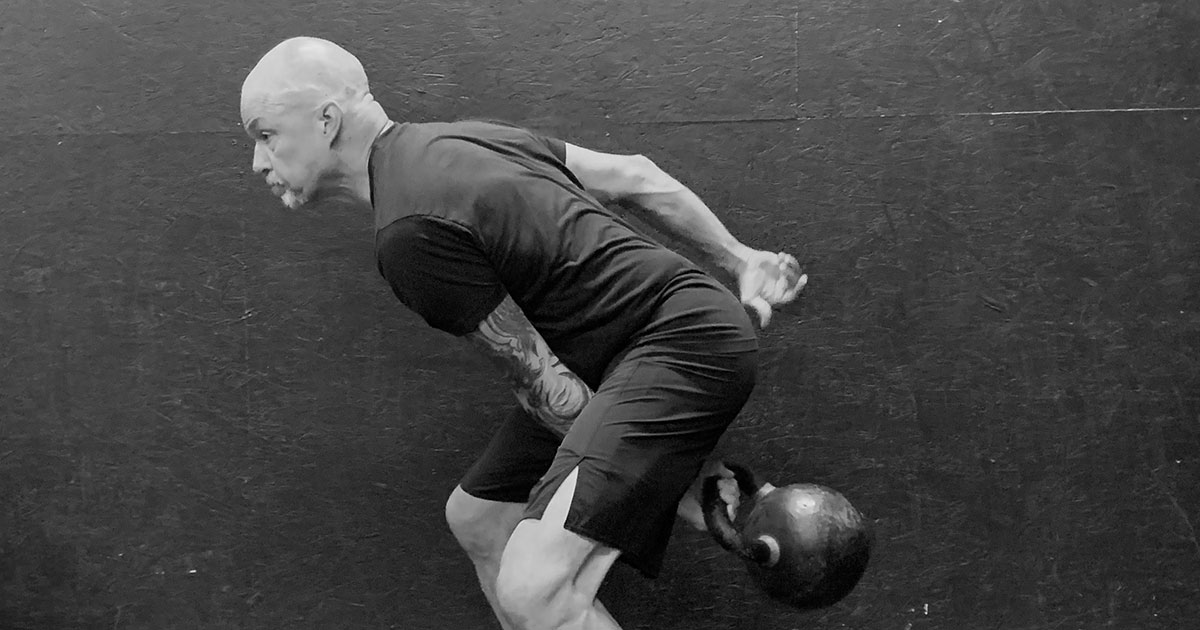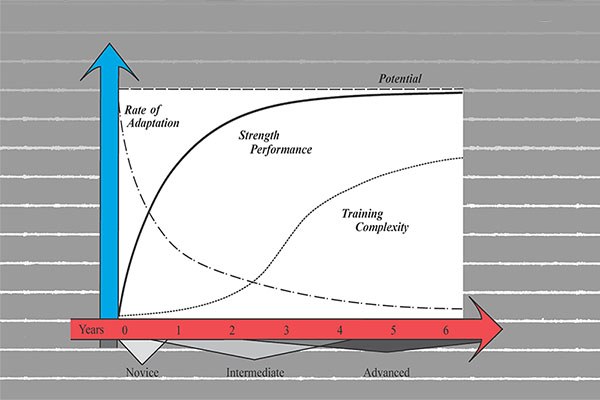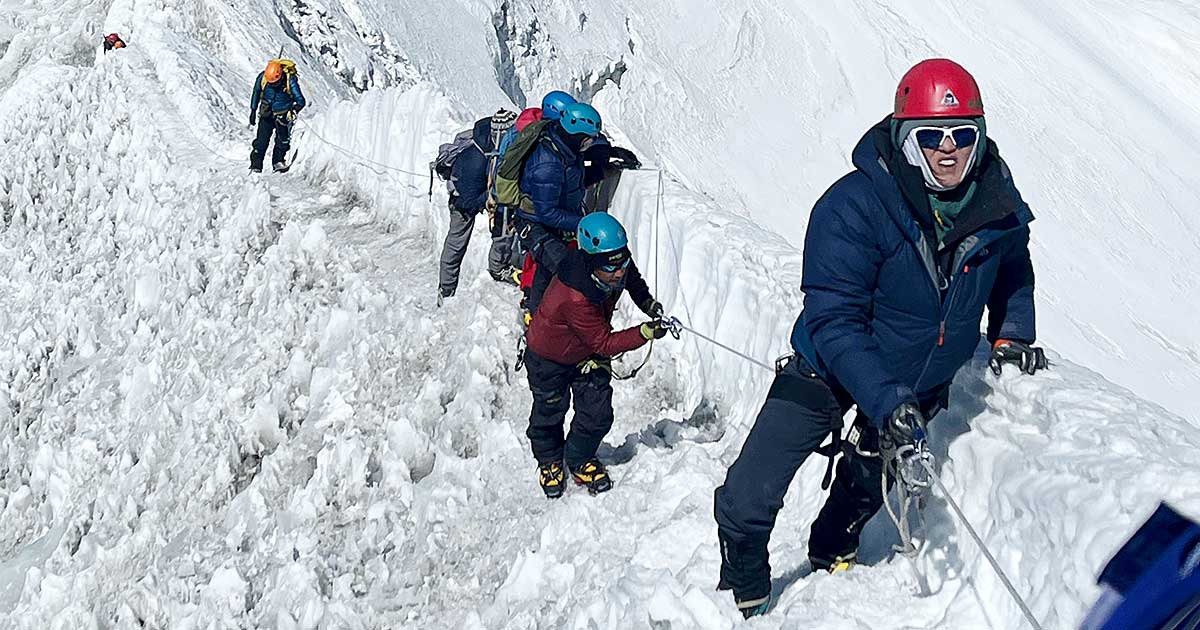My Background
I’m a 55-year-old male (schoolteacher by day) who weighs 177 pounds and stands just over 5’9”. The focus of my forties, honestly, was CrossFit. This included eight years of WODs, Metcons, and hero workouts. I learned a lot, attaining multiple certifications including CrossFit L1 and L2, weightlifting, gymnastics, and a myriad of other CrossFit continuing education courses. I coached for six of those years at a local “box.” It was a family affair and brought my family together in fitness.
Back then, the CrossFit kettlebell course had faded out, but luckily my coach had spent a long weekend with Jeff Martone just before that happened. He incorporated kettlebells into a lot of our strength training (and Metcons) at the gym. I got hooked.
Pretty soon I was reading a lot of Pavel’s work, buying most (maybe all) of his books, listening to him on the Tim Ferriss and Joe Rogan podcasts, and reading StrongFirst articles. I bulked up my own kettlebell collection at home to experiment and train outside the box. Eventually becoming known as the “kettlebell guy” at the gym, constantly touting their simple elegance and Pavel’s ingenious protocols. Eventually, my son and I took a day long StrongFirst workshop with the “Red Gorilla” in New Hampshire. Then, during Covid, I traded the double-under, Metcons, and box jumps for StrongFirst protocols and philosophy with kettlebell swings, rucking, bodyweight movements, and barbell work.
And so evolved my strength training in my fifties.
Before I took on the February Swing Challenge
In the corner of the living room of my Vermont house, an old and narrow, two-story home in Burlington, live an array of six kettlebells—12 through 32kg. They live at the head of the small room for all who enter to see. I sometimes think of it as what Pavel refers to as my “courage corner.” I don’t hide my kettlebells so that I can’t hide from them; though the handles boast chalky residue, none wear dust.
Often, they garner comments such as, “Quite a collection.” The response, in my head, is always the same, “Not really. Not yet.”
Others comment, “What are you training for?”
Again, in my head, and sometimes joking with my son, the answer is, “To be harder to kill.” I don’t say it out loud outside our circle because a lot of folks don’t quite “get” such a comment, thinking it violent or odd. But I think daily about training for life and its endlessly variable challenges.
It’s not really a joke, because something happens swinging those kettlebells several times a week. One does become harder and more resilient. StrongFirst might label it the “what the heck” effect. And though I’m no Jason Bourne (nor Derek Toshner nor Fabio Zonin), I can lift heavy stuff and do hard things, thanks, in part, to facing those heavy iron kettlebells day in and out.
Some benchmark training before the challenge included daily combinations of kettlebell swings or lifts, usually Simple, AXE, or Q&D swing protocols with a 32kg kettlebell and rucking with a 30-pound pack for 2.3 miles four days per week. I complemented those training modalities and structures with bodyweight exercises such as pullups and handstand walking. I also began deadlifting again after a year-plus hiatus, lifting 225lb for 5×5 sets once or twice a week, and even hit a 290lb lift at the top of a spontaneous ladder sequence in my unheated garage early one sub-zero morning in January, although that pull wasn’t as “buttery” as I wanted. I hike, ski, and keep relatively fit. I’m not a beast, just a guy wanting to be “harder to kill” in life.
I did complete a basic Simple test on January 28, but my notes read “a bit sloppy,” lacking snap in a few swings, “Iron taste in throat,” and a bit of lung burn. Room for improvement, as always.

When the February challenge email dinged my inbox on January 30, I had already been training consistently. I had some tangible goals but wanted to complete the Simple test with a 32kg kettlebell and the SFG snatch test for my gender and age group (using a 20kg kettlebell) sometime in mid-winter. But then came that email, and it sparked a fiery intention in me. It seemed as much a mental endurance test as a physical one.
The email read:
For the 29 days of this leap year, in February perform 100 swings and 10 get-ups daily.
Guidelines for “Leap into S&S”:
- This is in addition to not in place of your “regularly scheduled training.”
- Use a weight 70-80{08333bab68e0686bc73f751d713fa62282d5f4fe4cc6001c554e5bb20454a8c9} of your typical swing weight.
- Use 70-80{08333bab68e0686bc73f751d713fa62282d5f4fe4cc6001c554e5bb20454a8c9} power and intensity.
- Set a baseline by performing a Timeless 10×10 with your working weight on February 1st.
- Vary the sets, reps, and sequence.
- Obey the StrongFirst stop signs.
- Go lighter as needed.
- Enjoy!
Could I go for so many unbroken days and still abide by StrongFirst principles? Could I get stronger and avoid overtraining?
Could I become harder to kill rather than exhausted and vulnerable?
Accepting the Challenge
“Why not?” I thought.
The February challenge seemed a perfect way to sharpen my training focus and test my adaptability, offering a clear path to increased volume via sound underlying strength principles and stop signs: attention to form and rate of perceived exertion (RPE), load waving, and anti-glycolytic training. It might also tidy up my Simple performance by getting more time with kettlebells in hand, and maybe it would better prepare me to “own” the snatch test at 20kg.
I re-read the email several times, noting the ideas about swinging a lighter kettlebell on days when the 100 were supplementary or complementary to other training. The math put me at a 24kg kettlebell as a go-to for complementary swings. I also noted the encouragement to “play” and mix it up by waving weight and changing up sets, reps, and timing.
“Let’s go,” I said to myself.
On February 1, I rucked with my 30-pound pack for about two and a half miles in the early morning, and then completed 100 one-arm swings, performing 5 reps OTM (on the minute) for 20 minutes and 10 standard “Simple” get-ups.
The challenge began without much trouble.
Then the grind set it. Deep into the first week, I was swinging, rucking, and mixing in some bodyweight work. I was tired, without question. My son, with whom I share a fitness passion, texted me, “How’s your posterior chain?”
“Fatigued, but not injured,” I wrote back. The increase in sheer volume was a rugged teacher.
By the end of the second week there were mornings, rucking uphill, I just felt slow. “Slow, but not damaged,” was my thought. “But diminished?” Bits of Pavel’s wisdom hummed in my mind. And I mentally translated the StrongFirst stop signs to my rucking. I didn’t want to train slow to be slow. I didn’t want to trade power just to complete a grind. So, next ruck, I kept watch on a big old clock that hangs on a brick building near our house, one that I pass on the way out and in each morning. My time didn’t waver from one ruck to the next. My body was tired, but my breathing wasn’t labored.

Objectively, I wasn’t slowing down. I was in, most probably, hormesis. My body was taxed but adapting and growing. To embrace the changes, I determined to keep the rucks in the mix, but dropped the sessions to three instead of four in the third week to stave off training slow or overtraining.
I also began more “creatively” waving loads and protocols with my swings. Within the AXE protocol, I threw in two-armed swings with my 32kg kettlebell, and sometimes I snatched the lighter kettlebells in a waved session. For example, I’d set up five kettlebells and move up and down the line for two sets of one-armed swings at each kettlebell for 20 or 30 minutes, sometimes snatching the 16kg, 20kg, and 24kg kettlebells. By February 28, I snatched a few with the 28kg kettlebell as well. On multiple days I returned to a basic S&S or Q&D protocol using the 32kg kettlebell, and sometimes the 24kg, the recommended lighter weight.
About that time, with my swing groove “greased,” I was inspired to complete a snatch test (for fun) while visiting my daughter. She has a 16kg kettlebell in her apartment, so one morning I just snatched sets of 20 OTM, finishing with get-ups, and then skiing the rest of the day with her. The day after that I swung that same 16kg for 100 unbroken one-arm swings in sets of 20, before moving into my get-ups combined with some presses.
The following week, the fourth week in, I adapted the training outside my swings again, replacing weighted rucks with longer mountain hikes and a return to faster legs on steeper terrain.
And then came February 28. One more day of 100 swings.
“How are you feeling?” my wife asked.
I hesitated. Tired. Sure. But also, good. Accomplished. And like I could go out and function in the world regardless of my training. I wasn’t limping or slogging through my days. And, quite honestly, the end felt bittersweet. That evening, I decided to complete the basic S&S protocol in the morning for my final 100 swings—a fitting cap for the challenge.
The Results
After waking up and drinking my coffee on February 29, I changed my mind about the S&S plan. I felt pretty good, so why not just try a snatch test? I told myself that if the first minute didn’t reveal quality form and power, I’d just turn it into a Q&D snatch session. And, really, such a test at the end of such a long bout of training would be testament to whether the training itself stood up and if I had properly attended to StrongFirst principles, philosophies, and stop signs.
I chalked my hands and turned up the music. Loud.

Five minutes later I’d completed one of my smoothest snatch tests to date. No burning lungs or hacking cough followed, only my 10 get-ups after a couple minutes rest. Then I loaded up my truck and headed to the mountains for a three-mile winter hike in the mountains with my dog.
Challenge completed. Test completed. Goal completed.
In reviewing the month, I think back to a February 6 email I received from StrongFirst, quoting Pavel: “Understanding is a delaying tactic…” The email then elaborated, extrapolated, and unpacked the quote with a learning-to-swim analogy. It’s not a Nike challenge of “Just do it…” but there is something to mastering principles under duress, which the challenge provided.
It made sense.
When I consider the completion of the 3,000+ swings, I think of it like this: though I think I understand Pavel when I read his work or view his lectures, I am no master of programming. Simply committing to the 100 or more swings and 10 get-ups every day of the “simple challenge” in addition to (and sometimes as) my regular training, forced me to live and practice sound philosophy like monitoring my RPE. StrongFirst’s most basic guidelines such as the talk test, proper form, and power output used as barometers within their “do this” protocols pushed me. It made me a better athlete, a more precise training practitioner, and a better thinker about the training, including the why and how.
The why and how came from doing. And doing became the why and how.
Subjectively, the month sharpened my physicality, increasing my fitness. I base this assertion on a few observations.
First, the perceived weight of my kettlebells, especially the heavier ones, felt lighter in my hands at the end of the month, such as when I spontaneously snatched the third reps of the 28kg during sessions of the AXE protocol. I equate this to just a slightly denser posterior chain from all the volume. The kettlebells floated more easily.
Second, my breathing became more relaxed in my standard training sessions as the month progressed, such as when I returned to a classic S&S session, revealing an increased aerobic capacity. The real reveal for me came near the end of the challenge, when I pushed that final AXE session on February 28 from a planned 20 minutes to 30, based on the talk test, form quality, and power output, and then my final snatch test. It was an easy day. My recovery was quick, and I moved smoothly into a multiple-hour hike in the snowy Green Mountains.
Third, though my weight remained constant, my shirts do feel slightly tighter around the chest and shoulders, and my pants are snugger over the quads, hips, and glutes.
Next, I would comment that the mental gains also seem substantial. I learned flexibility with purpose within my programming—getting in an “extra” or “standard” 100 swings daily takes some prep, but also some determined listening to one’s body. This seems analogous to a rule in poetry: repetition with variation. I think of Robert Frost’s adage about free verse, without form for function, he chided, you might as well be “playing tennis without a net.” Hence the attention to the baseline of 100 swings within the protocols, using the basic StrongFirst principles to guide proper execution.
Objectively:
- I completed over 3,000 swings throughout the month of February.
- I successfully and confidently completed a snatch test at the requisite weight for my age group.
- I re-tested and toned up my Simple test on the morning of March 3, without sloppiness or lung burn, and with a metronomic 50:50 work to rest ratio on the swings.
- I pulled that same 290-lb deadlift that I’d lifted in January, but smoothly and confidently, on two separate, subsequent days, as a sort of “let’s see” metric. The first lift occurred on March 1, the day following my swing challenge completion, and again on March 3, the afternoon after the Simple test. I knew I could most likely hit it once, but hitting it on two days, relatively close together after a training session revealed that I was acquiring “any day” versus “good day” strength.
Reflecting on Pavel’s words “understanding as a delaying tactic” and this challenge, reminds me of a common Zen adage about the pitfalls of trying too hard to “get” something with overplanning and overthinking. It goes something like, “Just sweep the floor.” By focusing your complete attention on the act of sweeping, the understanding will naturally come.
I appreciate and am grateful for StrongFirst, whose instruction has given me structure with insightful and science-based protocols, methods, philosophies, so that in a month like February, I can just “swing a kettlebell.”
“Kettlebell Simple & Sinister”—available as a book (paperback, Kindle, audio) and on video





